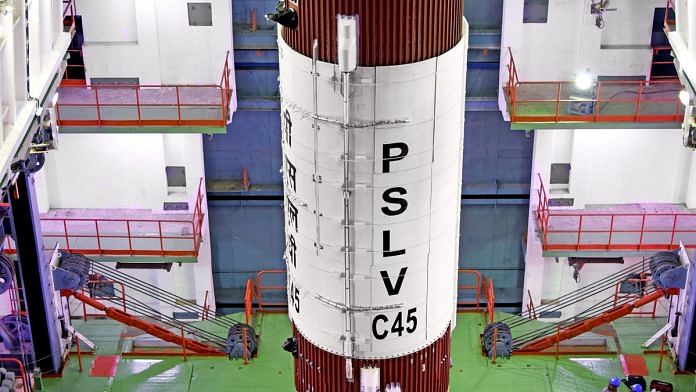Bengaluru: A mysterious Indian spy took off for space Monday as the Indian Space Research Organisation (ISRO) launched the PSLV-C45 EMISAT mission.
The mission marks more than one first for the space organisation.
For one, it is the first time that the PSLV will be launching and placing satellites in three different orbits, a manoeuvre that will require the fourth stage to be restarted twice: Once to deploy all customer satellites and another for the stage itself to settle into an orbit to function as a platform.
It is also the first time India’s workhorse PSLV has flown in a QL variant, with four XL strap-on motors instead of the standard six, which gives the launcher more options for speeds/altitudes to deliver payloads.
This will also be PSLV’s longest mission, with an expected duration of three hours.
Eye in the sky
The primary payload, India’s Electromagnetic Intelligence Satellite (EMISAT), is an electronic intelligence (ELINT) satellite. Weighing 436 kg, it was designed based on the Indian Mini Satellite-2 (IMS-2) bus platform.
It is an electromagnetic spectrum instrument that was developed by the Defence Research and Development Organisation (DRDO) and ISRO under Project Kautilya with a budget of Rs 432.8 crore.
Often referred to as electronic spy satellites, ELINT satellites are reconnaissance platforms used for defence purposes. Thus, typically, not a lot of details are released to the public about them.
Theoretically, the satellite will be able to intercept and monitor radio signals, and then find out their source and location. EMISAT could potentially do more.
“The EMISAT has been developed for monitoring radar network by India,” Ratan Shrivastava, adviser at industry body FICCI’s space division, was quoted as saying in an interview last week.
EMISAT has been in the works for almost eight years now. It’s yet unclear whether EMISAT would eventually be a constellation of signal-intercepting satellites or just a single eavesdropper.
EMISAT will be injected into a sun-synchronous circular orbit of 749 km.
Also read: In a first, ISRO to launch PSLV-C45 with three-tier orbit deployments
Customer satellites
The PSLV also has on board 28 international customer satellites, which will be deployed back-to-back in an orbit of 504 km.
Twenty of these small and sturdy satellites are imaging satellites belonging to the American company Planet Labs, which provides, among other things, agricultural and military services to the US government. The company had recently condemned India’s A-SAT test.
Planet’s response to India’s testing of an anti-satellite missile. pic.twitter.com/bZuuIYtCFB
— Planet (@planetlabs) March 27, 2019
Planet Labs has so far deployed nearly 300 of these ‘Dove’ satellites into orbit, which can image up to a three-metre resolution.
Another American company, Spire Global, launched four Lemur-2 satellites on this mission for vessel identification. Texas-based AST&Science, in collaboration with Lithuania, launched two satellites for satellite communications and for “internet-of-things communication network”, while the Swiss company Astrocast SA launched one for internet of things, and Spain’s AISTech, one for remote asset management and aircraft-tracking.
Launcher as a platform
After launching the satellites, the fourth stage of the PSLV will reorient itself to settle into an orbit of 485 km. In orbit, it will function as a platform that can enable science experiments for the three other payloads attached to it.
The stage hosts an array of solar panels and antennae, so the payloads don’t carry them.
The three payloads are from ISRO, the Radio Amateur Satellite Corporation (Amsat, a global group of amateur radio operators) India, and the Indian Institute of Space Science & Technology (IIST), Thiruvananthapuram.
ISRO’s payload, the Automatic Identification System (AIS), is a maritime satellite that will be used to help in navigation on water, capturing messages from ships.
The Automatic Packet Repeating System (APRS) satellite that hitched a ride on the rocket to use the fourth stage is the Indian-made Exseed Sat2. It was manufactured for Amsat India, and contains a “digipeater” — a mirror and amplifier for repeating digital signals and retransmitting them on the same frequency. The satellite will provide services for amateur radio operators across the globe.
The student satellite launched by IIST is called the Advanced Retarding Potential Analyzer for Ionospheric Studies (ARIS), and will study the structure and composition of the ionosphere.
Also read: ISRO sets up centre in Bengaluru for manned space mission Gaganyaan
This is an updated version of the report



